Kinetics of Macro and Micronutrients during Germination of Habanero Pepper Seeds in Response to Imbibition
Abstract
1. Introduction
2. Materials and Methods
2.1. Obtaining Plant Material
2.2. Mineral Elements Analysis of Seeds and Seedlings
2.3. Analysis of Germination and Electrical Conductivity
2.4. Statistical Analysis and Experimental Design
3. Results and Discussion
3.1. Concentration and Distribution of Mineral Elements (K, Ca, Fe, P, Mg, and Mn) in Seeds and Seedlings
3.1.1. Potassium (K)
3.1.2. Calcium (Ca)
3.1.3. Phosphorus (P)
3.1.4. Iron (Fe)
3.1.5. Magnesium (Mg)
3.1.6. Manganese (Mn)
3.2. Germination and Electrical Conductivity
4. Conclusions
Author Contributions
Funding
Institutional Review Board Statement
Informed Consent Statement
Data Availability Statement
Acknowledgments
Conflicts of Interest
References
- Lee, I.O.; Lee, K.H.; Pyo, J.H.; Choi, Y.J.; Lee, Y.C. Anti- inflammatory effect of capsaicin in Helicobacter pylori infected gastric epithelial cells. Helicobacter 2007, 12, 510–517. [Google Scholar] [CrossRef] [PubMed]
- Rithesh, M.; Dangi, R.S.; Dass, S.C.; Malhothra, R.C. The hottest chilli variety in India. Curr. Sci. 2000, 79, 287–288. [Google Scholar]
- Garruña-Hernández, R.; Latournerie-Moreno, L.; Ayala-Garay, O.; Santamaría, J.M.; Pinzón-López, L. Acondicionamiento pre-siembra: Una opción para incrementar la germinación de semillas de chile habanero (Capsicum chinense Jacq.). Agrociencia 2014, 48, 413–423. [Google Scholar]
- Iwai, T.; Takahashi, M.; Oda, K.; Terada, Y.; Yoshida, K. Dynamic changes in the distribution of minerals in relation to phytic acid accumulation during rice seed development. Plant Physiol. 2012, 160, 2007–2014. [Google Scholar] [CrossRef] [PubMed]
- Lombi, E.; Smith, E.; Hansen, T.H.; Paterson, D.; De Jonge, M.; Howard, D.L.; Persson, D.P.; Husted, S.; Ryan, C.; Schjoerring, J.K. Megapixel imaging of (micro) nutrients in mature barley grains. J. Exp. Bot. 2010, 62, 273–282. [Google Scholar] [CrossRef]
- Vidigal, D.S.; Dias, D.C.F.S.; Von-Pinho, E.R.V.; Dias, L.A.S. Sweet pepper seed quality and lea-protein activity in relation to fruit maturation and post-harvest storage. Seed Sci. Technol. 2009, 37, 192–201. [Google Scholar] [CrossRef]
- Ayala-Villegas, M.J.; Ayala-Garay, O.J.; Aguilar-Rincón, V.H.; Corona-Torres, T. Evolución de la calidad de semilla de Capsicum annuum L. durante su desarrollo en el fruto. Rev. Fitotec. Mex. 2014, 37, 79–87. [Google Scholar] [CrossRef]
- Dias, D.C.F.S.; Ribeiro, F.P.; Dias, L.A.S.; Silva, D.J.H.; Vidigal, D.S. Tomato seed quality harvested from different trusses. Seed Sci. Technol. 2006, 34, 681–689. [Google Scholar] [CrossRef]
- Vidigal, D.S.; Dias, D.C.F.S.; Dias, L.A.S.; Finger, F.L. Changes in seed quality during fruit maturation of sweet pepper. Sci. Agric. 2011, 68, 535–539. [Google Scholar] [CrossRef]
- Caixeta, F.; Von Pinho, E.V.R.; Guimarães, R.M.; Pereira, P.H.A.R. Determinação de ponto de colheita na produção de sementes de pimenta malagueta e alterações bioquímicas durante o armazenamento e a germinação. Científica 2014, 42, 187. [Google Scholar] [CrossRef][Green Version]
- Bewley, J.D.; Black, M. Seeds: Physiology of Development and Germination, 2nd ed.; Plenum Press: New York, NY, USA, 1994; Volume 445. [Google Scholar]
- Smiciklas, K.D.; Mullen, R.E.; Carlson, R.E.; Knapp, A.D. Drought-induced stress effect on soybean seed calcium and quality. Crop Sci. 1989, 29, 1519–1523. [Google Scholar] [CrossRef]
- Xu, G.; Kafkafi, U.; Wolf, S.; Sugimoto, Y. Mother plant nutrition status and growing condition affect assimilates and emergence quality of hybrid sweet pepper seeds. J. Plant Nutr. 2002, 25, 1645–1665. [Google Scholar] [CrossRef]
- Welch, R.M. Effects of nutrient deficiencies on seed production and quality. In Advances in Plant Nutrition; Tinker, P.B., Lauchli, A., Eds.; Praeger: New York, NY, USA, 1986; Volume 2, pp. 205–247. [Google Scholar]
- Keiser, J.R.; Mullen, R.E. Calcium and relative humidity effects on soybean seed nutrition and seed quality. Crop Sci. 1993, 33, 1345–1349. [Google Scholar] [CrossRef]
- Lott, J.N.A.; Greenwood, J.S.; Batten, G.D. Mechanisms and regulation of mineral nutrient storage during seed development. In Seed Development and Germination; Kigel, J., Galili, G., Eds.; Marcel Dekker: New York, NY, USA, 1995; pp. 215–235. [Google Scholar]
- Hernández-Pinto, C.; Garruña, R.; Andueza-Noh, R.; Hernández-Núñez, E.; Zavala-León, M.J.; Pérez-Gutiérrez, A. Post-harvest storage of fruits: An alternative to improve physiological quality in habanero pepper seeds. Rev. Bio Cienc. 2020, 7, 1–15. [Google Scholar]
- Hill, T.; Sirbescu, M. Micro-XRF mapping of chemically zoned beryl: Fast, non-destructive, and precise. Microsc. Microanal. 2022, 28, 624–628. [Google Scholar] [CrossRef]
- Pacheco, N.; Méndez-Campos, G.K.; Herrera-Pol, I.E.; Alvarado-López, C.J.; Ramos-Díaz, A.; Ayora-Talavera, T.; Talcott, S.U.; Cuevas-Bernardino, J.C. Physicochemical composition, phytochemical analysis and biological activity of ciricote (Cordia dodecandra A. D.C.) fruit from Yucatán. Nat. Prod. Res. 2022, 36, 440–444. [Google Scholar] [CrossRef]
- Marrush, M.; Yamaguchi, M.; Saltveit, M.E. Effect of potassium nutrition during bell pepper seed development on vivipary and endogenous levels of abscisic acid (ABA). J. Am. Soc. Hortic. Sci. 1998, 123, 925–930. [Google Scholar] [CrossRef]
- Chen, P.; Lott, J.N.A. Studies of Capsicum annuum seeds: Structure, storage reserves, and mineral nutrients. Can. J. Bot. 1992, 70, 518–529. [Google Scholar] [CrossRef]
- Mazzolini, A.P.; Pallaghy, C.K.; Legge, G.J.F. Quantitative microanalysis of Mn, Zn and other elements in mature wheat seed. New Phytol. 1985, 100, 483–509. [Google Scholar] [CrossRef]
- Xu, G.; Kafkafi, U. Seasonal differences in mineral content, distribution and leakage of sweet pepper sedes. Ann. Appl. Biol. 2003, 143, 45–52. [Google Scholar] [CrossRef]
- Marschner, H. Mineral Nutrition of Higher Plants, 2nd ed.; Academic Press: San Diego, CA, USA, 1995; pp. 285–312. [Google Scholar]
- Hussain, S.; Khan, F.; Hussain, H.A.; Nie, L. Physiological and biochemical mechanisms of seed priming induced chilling tolerance in rice cultivars. Front. Plant Sci. 2016, 7, 116. [Google Scholar] [CrossRef]
- McCarty, D.R. Genetic control and integration of maturation and germination pathways in seed development. Annu. Rev. Plant Physiol. Plant Mol. Biol. 1995, 46, 71–93. [Google Scholar] [CrossRef]
- Ogawa, M.; Tanaka, K.; Kasai, Z. Isolation of high phytin containing particles from rice grains using an aqueous polymer two phase system. Agric. Biol. Chem. 1975, 39, 695–700. [Google Scholar] [CrossRef]
- Mori, S.; Fujimoto, H.; Watanabe, S.; Ishioka, G.; Okabe, A.; Kamei, M.; Yamauchi, M. Physiological performance of iron-coated primed rice seeds under submerged conditions and the stimulation of coleoptile elongation in primed rice seeds under anoxia. Soil Sci. Plant Nutr. 2012, 56, 469–478. [Google Scholar] [CrossRef][Green Version]
- Mondal, S.; Bandana, B. Impact of micronutrient seed priming on germination, growth, development, nutritional status and yield aspects of plants. J. Plant Nutr. 2019, 42, 2577–2599. [Google Scholar] [CrossRef]
- Borg, S.; Brinch-Pedersen, H.; Tauris, B.; Holm, P.B. Iron transport, deposition and bioavailability in the wheat and barley grain. Plant Soil 2009, 325, 15–24. [Google Scholar] [CrossRef]
- Lu, L.; Tian, S.; Liao, H.; Zhang, J.; Yang, X.; Labavitch, J.; Chen, W. Analysis of metal element distributions in rice (Oryza sativa L.) seeds and relocation during germination based on X-Ray fluorescence imaging of Zn, Fe, K, Ca, and Mn. PLoS ONE 2013, 8, e57360. [Google Scholar] [CrossRef]
- Shaul, O. Magnesium transport and function in plants: The tip of the iceberg. Biometals 2002, 15, 309–323. [Google Scholar] [CrossRef]
- White, P.J.; Broadley, M.R. Biofortification of crops with seven mineral elements often lacking in human diets-iron, zinc, copper, calcium, magnesium, selenium and iodine. New Phytol. 2009, 182, 49–84. [Google Scholar] [CrossRef]
- Yao, Y.; Wang, J.; Ma, X.; Lutts, S.; Sun, C.; Ma, J.; Yang, Y.; Achal, V.; Xu, G. Proteomic analysis of Mn-induced resistance to powdery mildew in grapevine. J. Exp. Bot. 2012, 63, 5155–5170. [Google Scholar] [CrossRef]
- Borisjuk, L.; Neuberger, T.; Schwender, J. Seed architecture shapes embryo metabolism in oilseed rape. Plant Cell 2013, 25, 1625–1640. [Google Scholar] [CrossRef]
- Longenecker, N.E.; Marcar, N.E.; Graham, R.D. Increased manganese content of barley seeds can increase grain yield in manganese-deficient conditions. Aust. J. Agric. Res. 1991, 42, 1065–1074. [Google Scholar] [CrossRef]
- Babaeva, E.Y.; Volobueva, V.F.; Yagodin, B.A.; Klimakhin, G.I. Sowing quality and productivity of Echinacea purpurea in relation to soaking the seed in manganese and zinc solutions. Izv. Timiryazevskoi Sel’skokhozyaistvennoi Akad. 1999, 4, 73–80. [Google Scholar]
- Wann, E.V. Leaching of metabolites during imbibition of sweet corn seed of different endosperm genotypes. Crop Sci. 1986, 26, 731–733. [Google Scholar] [CrossRef]
- McDonald, M.B. Seed quality assessment. Seed Sci. Res. 1998, 8, 265–275. [Google Scholar] [CrossRef]
- Bewley, J.D.; Bradford, K.J.; Hilhorst, W.M.H.; Nonogaky, H. Seed: Physiology of Development, Germination and Dormancy, 3rd ed.; Springer: New York, NY, USA, 2013; p. 392. [Google Scholar]
- Sanchez, V.M.; Sundstrom, F.J.; Lang, N.S. Plant size influences bell pepper seed quality and yield. HortScience 1993, 28, 809–811. [Google Scholar] [CrossRef]
- Shephard, H.L.; Naylor, R.E.L. Effect of the seed coat on water uptake and electrolyte leakage of sorghum (Sorghum bicolor L. Moench) seeds. Ann. Appl. Biol. 1996, 129, 125–136. [Google Scholar] [CrossRef]
- Rehman, S.; Harris, P.J.C.; Bourne, W.F. The effect of sodium chloride on the Ca2+, K+ and Na+ concentrations of the seed coat and embryo of Acacia tortilis and A. coriacea. Annu. Appl. Biol. 1998, 133, 269–279. [Google Scholar] [CrossRef]
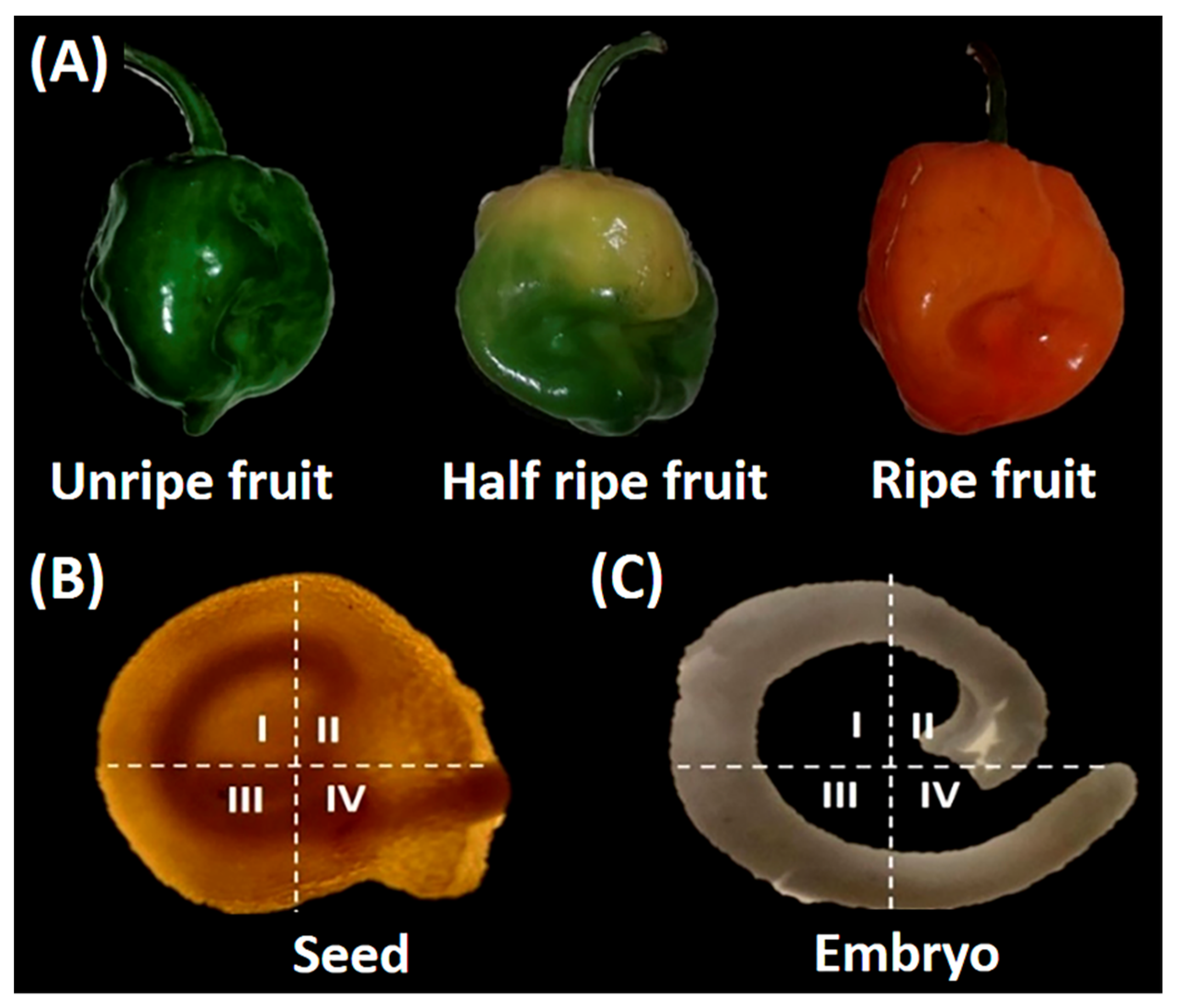
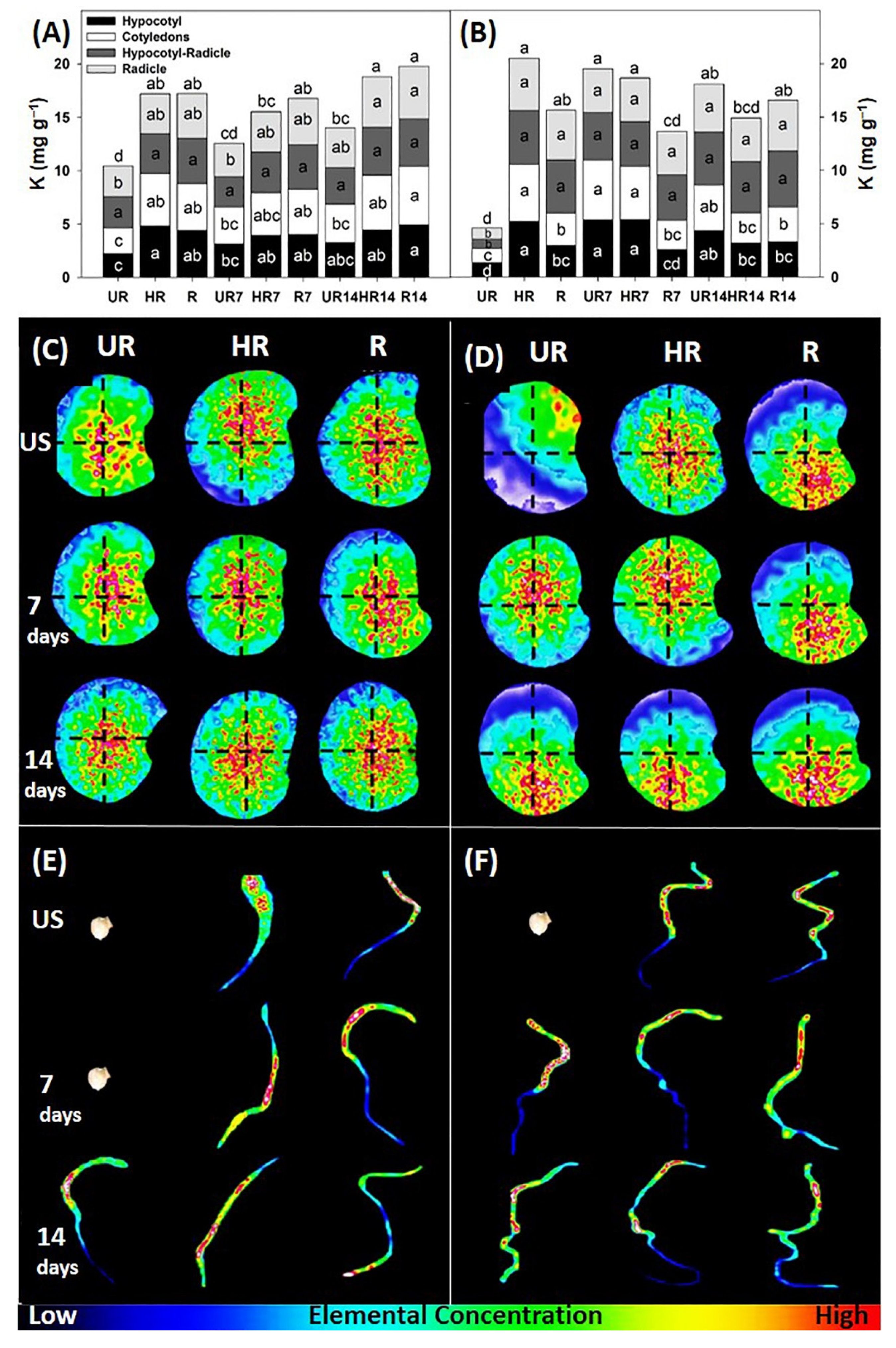
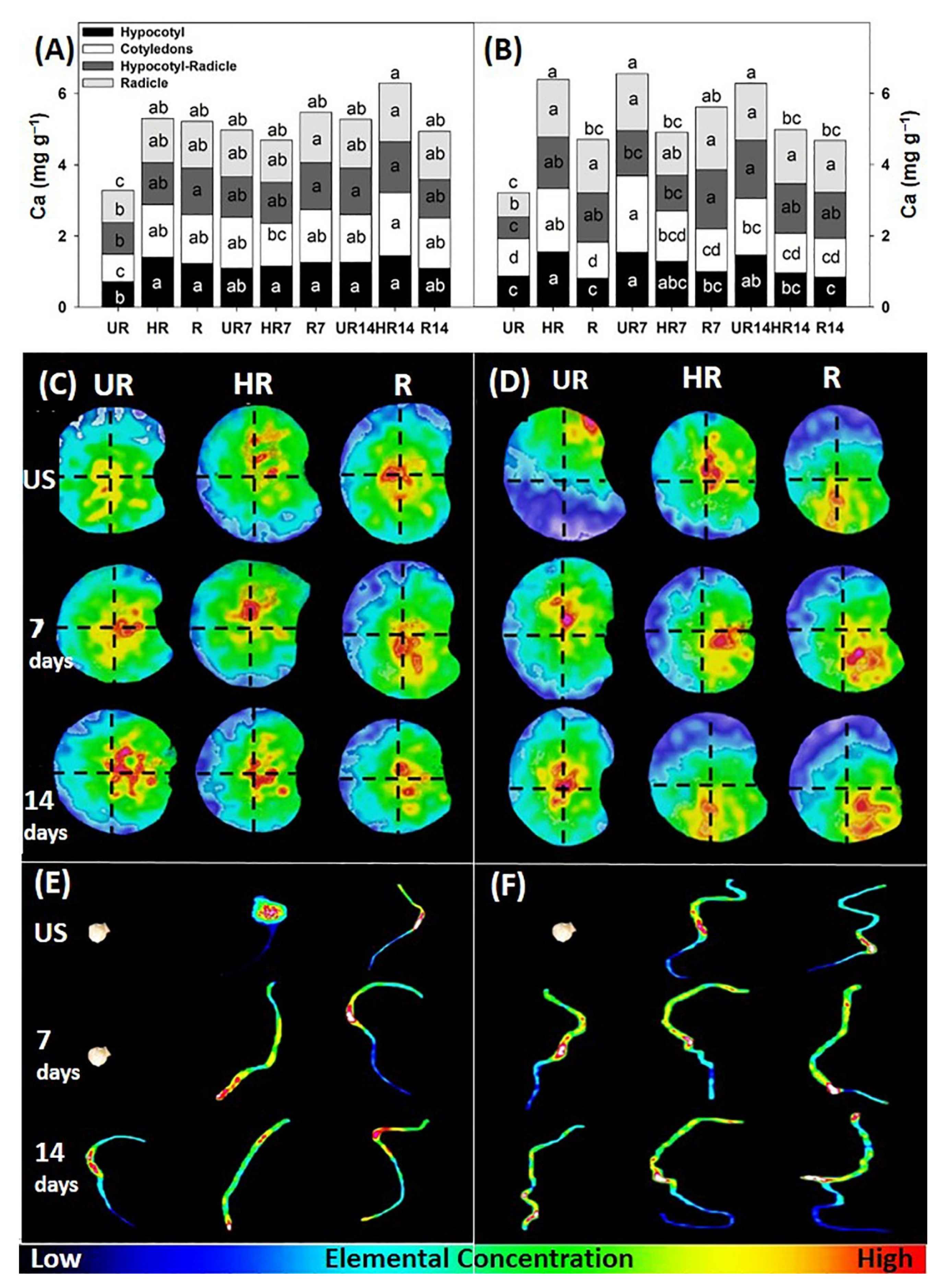
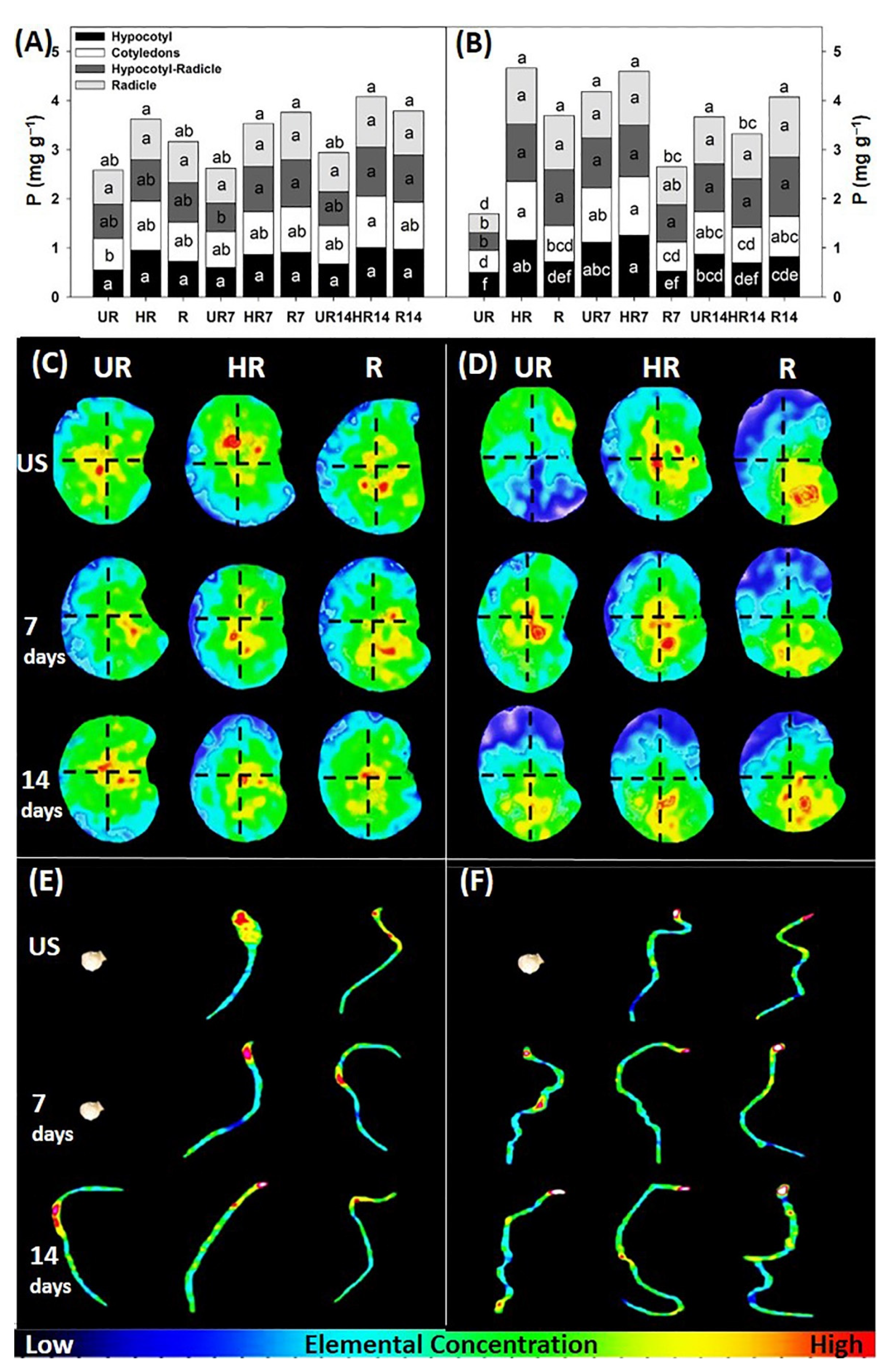
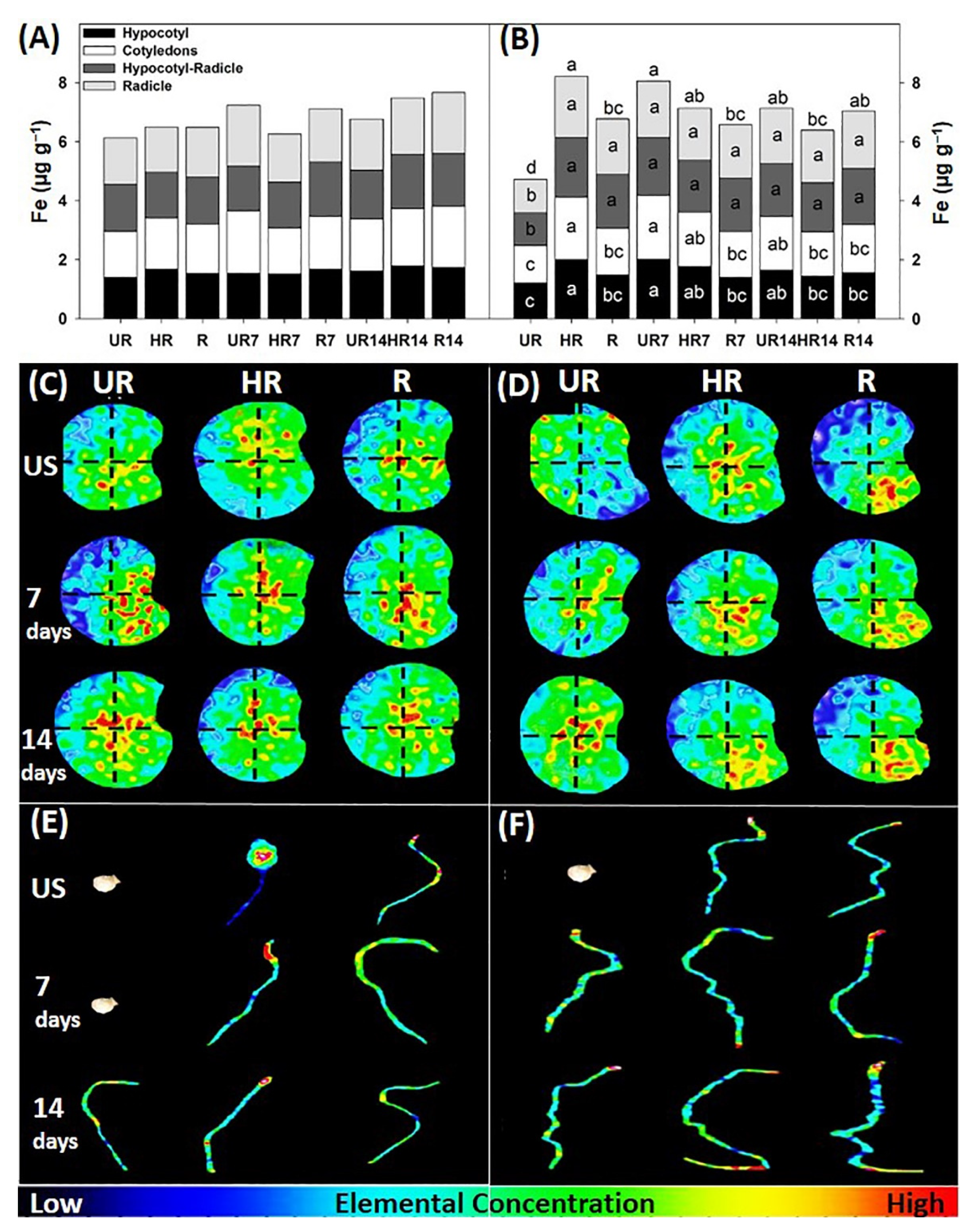

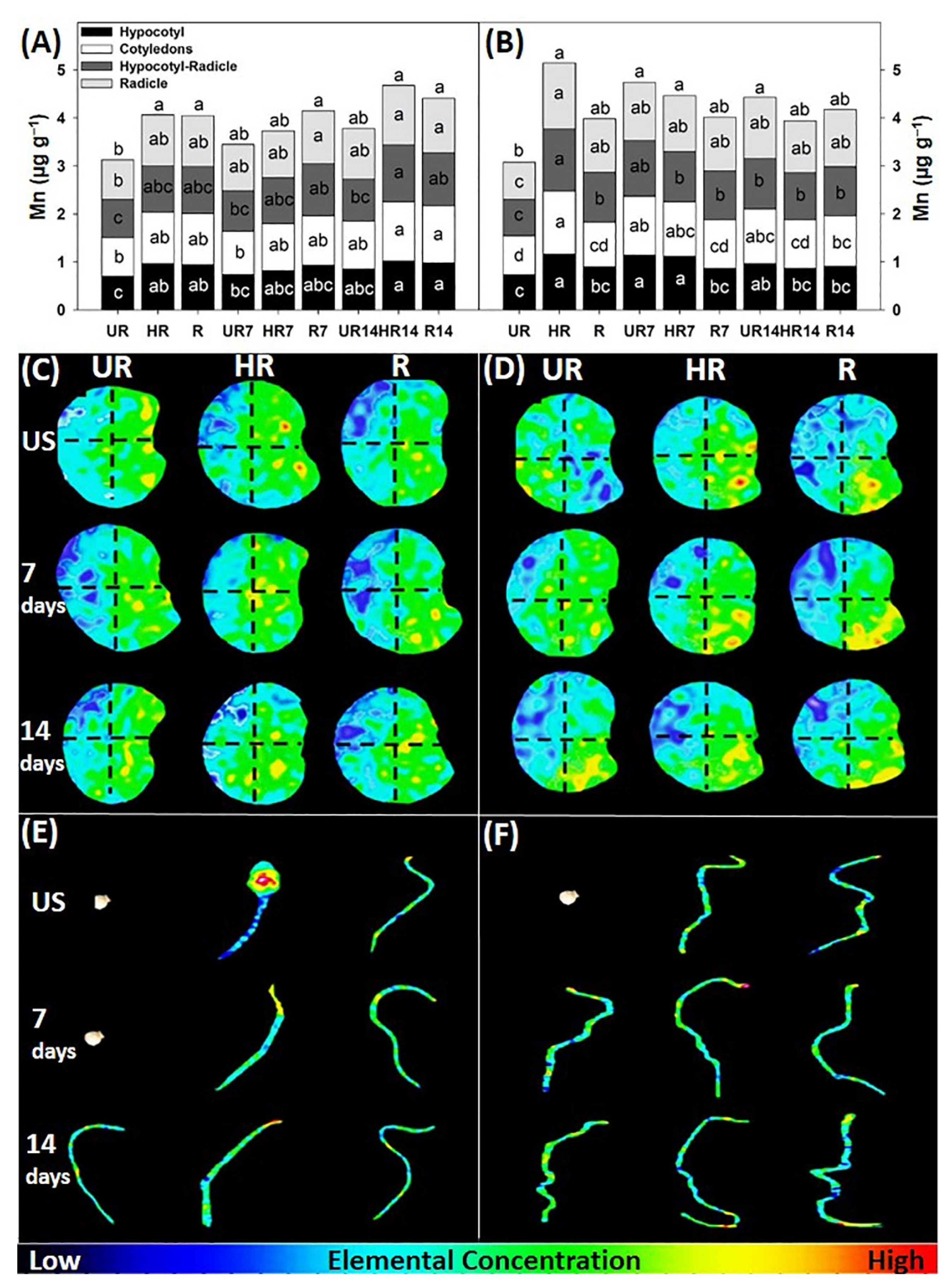
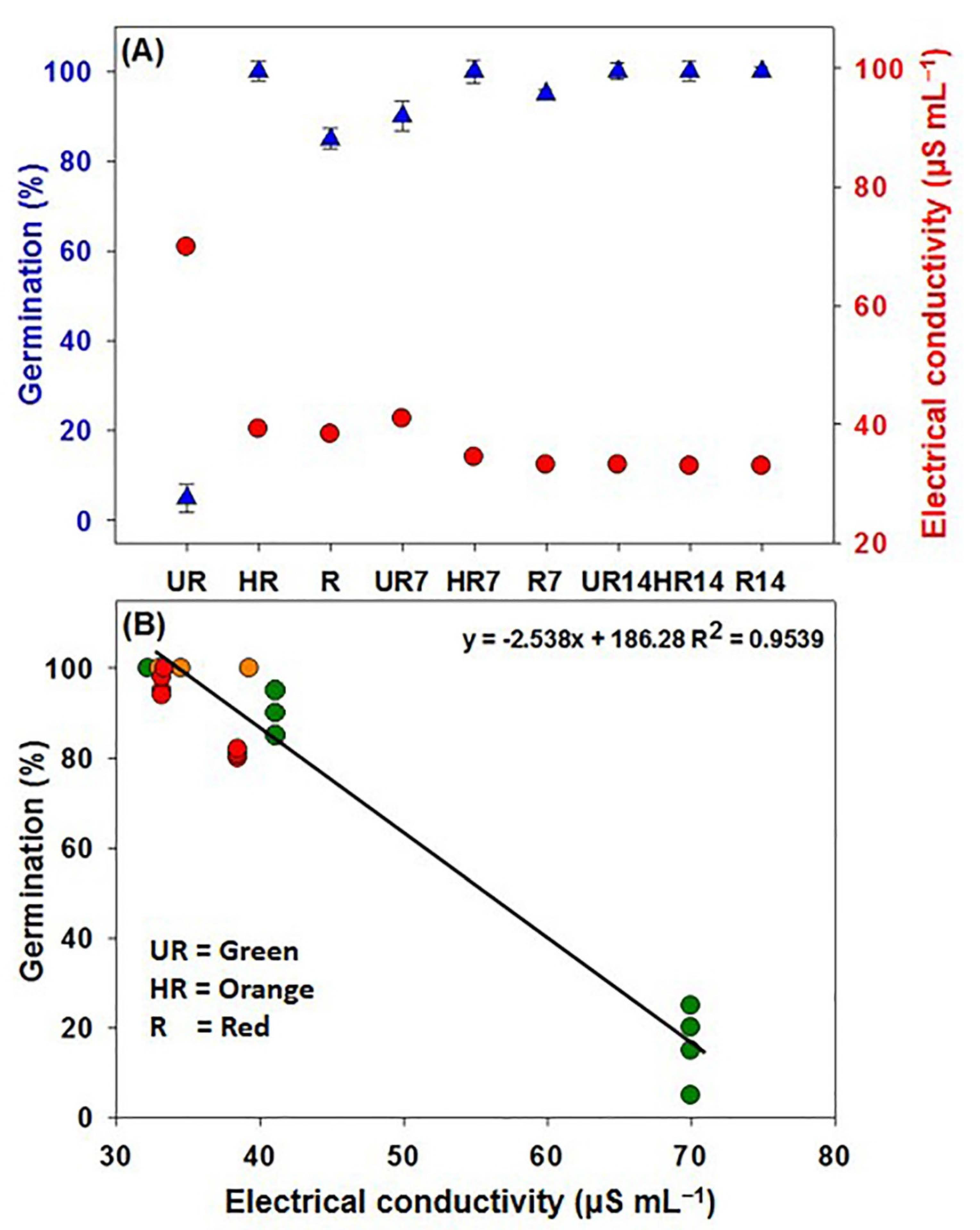
| Factors | K | Ca | Mg | Fe | P | Mn | %G | EC |
|---|---|---|---|---|---|---|---|---|
| FMS | 20.95 ** | 12.35 * | 8.79 * | 3.58 ns | 8.13 * | 20.41 * | 86.09 * | 20.60 ** |
| PSF | 9.15 ** | 10.98 * | 10.16 * | 1.50 ns | 13.92 * | 10.85 * | 162.53 ** | 53.60 ** |
| SI | 127.88 ** | 11.49 * | 4.89 * | 0.80 * | 5.76 * | 8.70 * | 20.77 ** | 14.20 ** |
| FMS × PSF × SI | 7.21 ** | 11.31 * | 3.65 * | 1.18 * | 2.85 * | 1.77 * | 55.04 ** | 23.15 ** |
| CV | 5.66 | 9.39 | 5.49 | 8.23 | 6.71 | 8.17 | 9.25 | 10.74 |
Publisher’s Note: MDPI stays neutral with regard to jurisdictional claims in published maps and institutional affiliations. |
© 2022 by the authors. Licensee MDPI, Basel, Switzerland. This article is an open access article distributed under the terms and conditions of the Creative Commons Attribution (CC BY) license (https://creativecommons.org/licenses/by/4.0/).
Share and Cite
Hernández-Pinto, C.D.; Alvarado-López, C.J.; Garruña, R.; Andueza-Noh, R.H.; Hernández-Núñez, E.; Zamora-Bustillos, R.; Ballina-Gómez, H.S.; Ruiz-Sánchez, E.; Samaniego-Gámez, B.Y.; Samaniego-Gámez, S.U.; et al. Kinetics of Macro and Micronutrients during Germination of Habanero Pepper Seeds in Response to Imbibition. Agronomy 2022, 12, 2117. https://doi.org/10.3390/agronomy12092117
Hernández-Pinto CD, Alvarado-López CJ, Garruña R, Andueza-Noh RH, Hernández-Núñez E, Zamora-Bustillos R, Ballina-Gómez HS, Ruiz-Sánchez E, Samaniego-Gámez BY, Samaniego-Gámez SU, et al. Kinetics of Macro and Micronutrients during Germination of Habanero Pepper Seeds in Response to Imbibition. Agronomy. 2022; 12(9):2117. https://doi.org/10.3390/agronomy12092117
Chicago/Turabian StyleHernández-Pinto, Carlos D., Carlos J. Alvarado-López, René Garruña, Rubén H. Andueza-Noh, Emanuel Hernández-Núñez, Roberto Zamora-Bustillos, Horacio S. Ballina-Gómez, Esaú Ruiz-Sánchez, Blancka Y. Samaniego-Gámez, Samuel U. Samaniego-Gámez, and et al. 2022. "Kinetics of Macro and Micronutrients during Germination of Habanero Pepper Seeds in Response to Imbibition" Agronomy 12, no. 9: 2117. https://doi.org/10.3390/agronomy12092117
APA StyleHernández-Pinto, C. D., Alvarado-López, C. J., Garruña, R., Andueza-Noh, R. H., Hernández-Núñez, E., Zamora-Bustillos, R., Ballina-Gómez, H. S., Ruiz-Sánchez, E., Samaniego-Gámez, B. Y., Samaniego-Gámez, S. U., & Latournerie-Moreno, L. (2022). Kinetics of Macro and Micronutrients during Germination of Habanero Pepper Seeds in Response to Imbibition. Agronomy, 12(9), 2117. https://doi.org/10.3390/agronomy12092117






